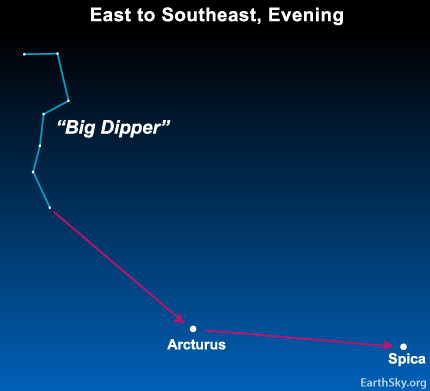Drive a spike to the star Spica on these May evenings. You’ll always find the star Spica, the brightest star in the constellation Virgo the Maiden, in the same place in the sky on May evenings every year.
Yesterday we talked about learning to “follow the arc” to the star Arcturus in the constellation Bootes. You just follow the curve in the Big Dipper’s handle until you see this orange star.
Tonight, let the Big Dipper introduce you Spica, the brightest star in the constellation Virgo the Maiden. You can follow the arc to Arcturus AND drive a spike or, as some say, speed on to Spica.
Enjoying EarthSky so far? Sign up for our free daily newsletter today!
The above chart shows a wide sweep of sky, from northeast to southeast around nightfall. First follow the curve made by these stars in the Big Dipper’s handle to the star Arcturus in the constellation Bootes: follow the arc to Arcturus. Now extend the curve in the handle into the southeastern sky: drive a spike to Spica. Or: speed on to Spica.

Spica in the constellation Virgo looks like one star, but this single point of light is really a multiple star system – with two hot stars orbiting very close together – located an estimated distance of 262 light-years away from Earth. Spica’s constellation, Virgo, is large and rambling and difficult to see. But you can look for a little squarish figure to the west (right) of Spica. This is the constellation Corvus the Crow, which we show on our May 15, 2017 Tonight’s sky.
Bottom line: On these May evenings, drive a spike to the sparkling blue-white star Spica.
Virgo? Here’s your constellation
EarthSky astronomy kits are perfect for beginners. Order today from the EarthSky store












